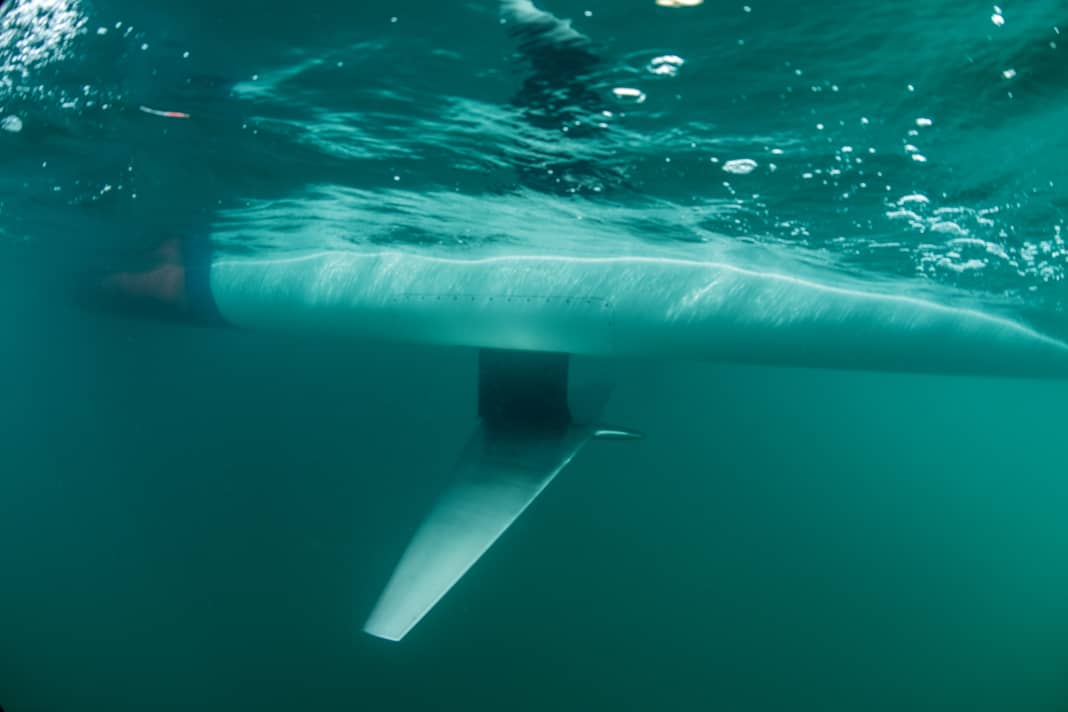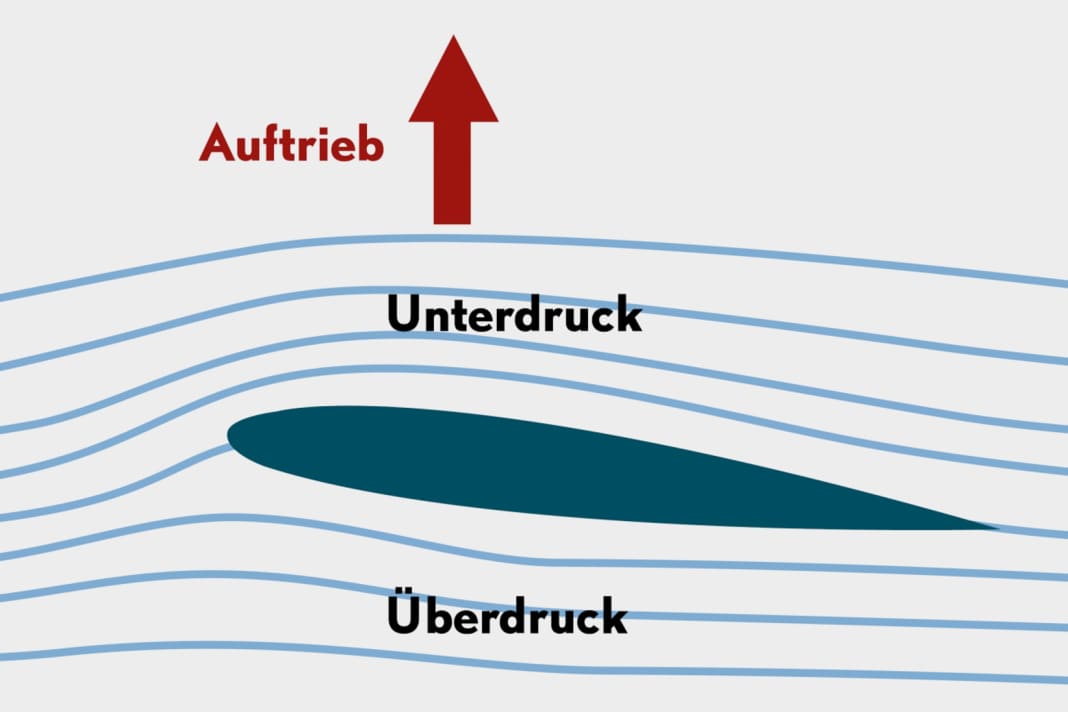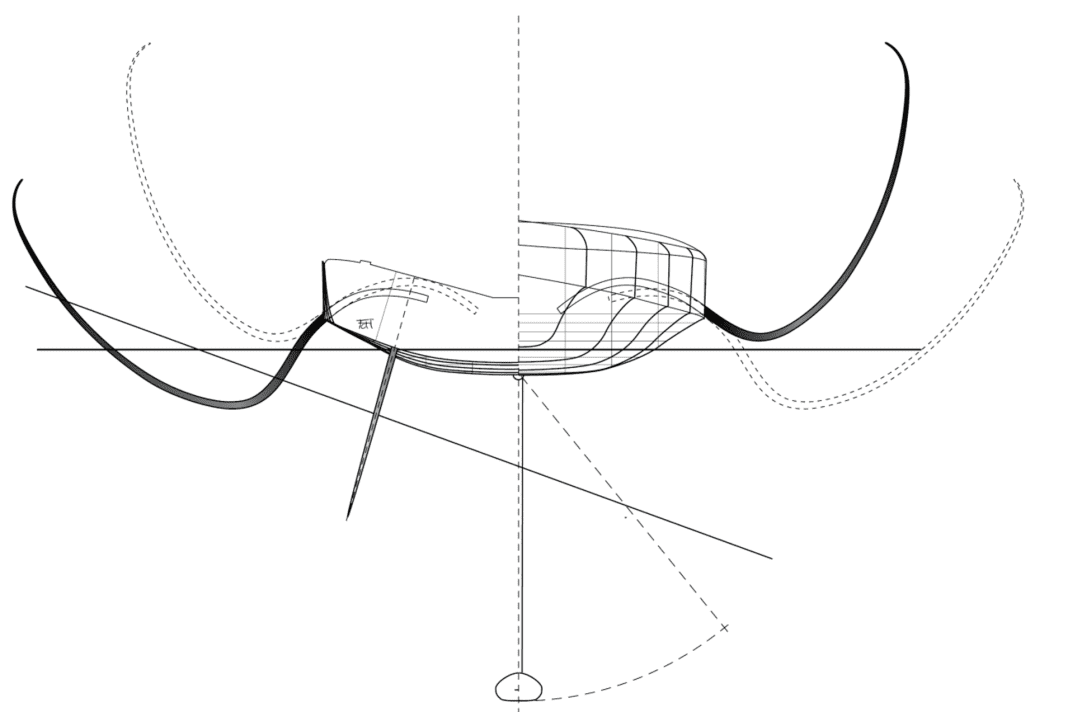Technology: "There is no such thing as the perfect foil" - how airfoils work
Andreas Fritsch
· 25.02.2024






YACHT: The SailGP regatta series recently tested new foils and reported an incredible 15 per cent jump in performance. That seems astonishing, as at the top end of the sport there is often a fight for every tenth of a knot. Is the foil technique still in its infancy so that such huge leaps are possible?
Martin Fischer: 15 per cent is definitely possible. However, they have tested a different configuration, so far these are so-called J-foils, i.e. bent inwards. When the boat is placed on the foil, the vertical lift of the wing, the centre of lift, is inside the hull. So you have a certain righting moment. And this is determined by how far apart the centre of gravity of the boat and the centre of buoyancy of the foil are in a lateral direction. However, the new profiles are T-foils, which are bent slightly outwards. This shifts the centre of lift of the wing outwards and the righting moment increases significantly, allowing more pressure to be applied to the sail. This means that 15 per cent more performance is possible.
If you had stayed with the J-Foil, would there not have been this significant increase?
Exactly. They haven't found a particularly clever new shape that has so much less resistance, but simply increased the power of the boat by ten to 15 per cent. It's as if you were to install an engine with 50 hp more in an existing car.
According to SailGP, the cavitation limit has also been pushed up by six knots and they now hope to reach 59 knots. Until now, many teams, such as the Imocas or Ultims, have said that above 50 knots is a kind of sound barrier for cavitation ...
In principle, this limit already exists. With a conventional foil, there is one side that has positive pressure and the other has negative pressure. At higher speeds, the negative pressure becomes so great that the vapour pressure of the water is undercut and it evaporates directly on the surface of the profile. This means that part of the foil is no longer working in liquid water, but in water vapour. This leads to a bubble wake, which drastically increases the drag. And if this happens on large parts of the wing, you can no longer go much faster. Typically, once cavitation has started, you can still achieve two or three knots more, but after that it's over. However, it is possible to build foils that only start to cavitate at 60 knots. But then they are pretty bad at lower speeds. An example: If we have a foil that kavits at 40 knots and one that kavits at 50, the one that starts at 40 is faster in the range between zero and 40 knots. And the other foil is then only between 40 and 50 knots faster. So that would be good in a lot of wind downwind, but on all other courses and in less wind the boat would be slower.
It doesn't matter in the SailGP, these are standardised class boats, they all use the same foil and the race committee decides which one to use. But in the America's Cup, the Imocas or Ultims, the choice is up to the team. In the open classes, you have to think carefully about when cavitation is allowed to start. It is an active design decision.
Different working states of a foil




So the idea of the border is basically wrong?
Yes and no. You can have cavitation even at ten knots. It just depends on the negative pressure of the airfoil. Let's take the Imoca foils: they cavitate at around 35 knots. This is done on purpose because an Open 60 doesn't sail any faster, it doesn't fly completely. That's why it makes no sense to use profiles that only kavit at 40 knots, but would be slower from zero to 33. But there is an upper limit. Beyond 60 knots, it becomes difficult not to kavit with a foil designed for use in liquid water. In addition to the high-speed aspect, there is also a cavitation problem at low speeds. If the foil is still to achieve sufficient lift, you have to work with a high angle of attack. Then, even at low speed, you have negative pressure peaks that cause the profile to cavitate locally at the top front even at low speed, which slows you down again.
The difficulty for foils in the America's Cup or SailGP is that with conventional profiles you can cover a speed range of 20 to 25 knots in which the foil does not cavitate at all. And you have to choose this range consciously, and it is difficult to increase. If you want to take off at 20 knots, your speed range without cavitation is 20 to 40 knots. If you want to reach 45 knots, the take-off speed is 25 knots.




Is it ideal to build as many foil sets as possible?
Actually yes, but in the America's Cup it's forbidden, we're only allowed to use one set of foils. This was done on purpose to keep the costs within reasonable limits, because they are extremely high. SailGP uses more profiles because of the different venues with very different wind conditions, so that the boats fly even in light winds.
How much does a set of foils for an AC boat cost?
One is well over a million euros, and with a reserve foil that's three to three and a half million euros. We didn't want teams to develop extreme profiles that could then lead to very large differences in speed. In that case, it becomes a game of poker: Which foil do I use in which wind? If you get it wrong, it's like driving on wet tyres in Formula 1 when it's dry. It is to be expected that all teams will design more or less all-round foils. That way we will have reasonable races with comparable speeds. This is also indicated by what we see in the tests with the LEQ12 boats: They have all developed in similar, moderate directions.
Isn't the higher weight of offshore boats like the Imocas and Ultims a problem, as they have to be much thicker as a result?
Thickness is always a problem with foils. The cavitation speed is determined by the percentage thickness. This means that a foil that is eleven per cent thick in relation to the chord length cavitates at 48 knots, one that is 16 per cent thick at 38 knots. This is the relative thickness. And of course you want to reduce the wetted surface. For example, you need to have five centimetres of thickness for strength reasons so that the foil doesn't break. If you then choose a ten per cent profile, that means a chord length of 50 centimetres. At 20 per cent, that means only 25 centimetres of chord length. So it's always about finding the best compromise between the expected cavitation and speed. Fast foils have to be thinner, but the wetted area is larger. This is why Imoca foils are around 14 per cent thick, SailGP foils around ten per cent. But it can be said that all foils, whether Imoca, Ultim, SailGP or America's Cup, are at the strength limit.
Does it actually make a big difference between the Imocas and the other foilers that they don't have T-foils on the rudders? This means they don't fly as stable as an America's Cupper, for example.
Yes, that makes a big difference. The lack of a T-rudder on the Imocas means that the stern sinks when the boat starts to fly. This increases the angle of attack of the main foil, too much lift is generated and the boat shoots out of the water at the front until it stalls on the main wing. The boat crashes down. So you don't achieve stable, long flight phases as with America's Cup, SailGP boats or the Ultims.
In a recent YACHT interview on the launch of the Ultims, Charles Caudrelier said that there will be no T-foils on offshore boats because they only work if they are regulated all the time, which a single-handed skipper can never do, and automatic systems are banned. Is that the case?
Yes, they need foils that regulate their own altitude. The first ones in the America's Cup were also like this, these J-foils. It works like this: There is always an angle between the foil shaft, which is actually always in the boat, and the tip: the tip goes inwards and slightly upwards. If you then sail and the boat flies at a certain height and the foil comes further out of the water due to more speed or a wave, it reduces the surface area of the shaft in the water. As a result, the drift to leeward increases. And the drift reduces the angle of attack of the water at the tip. This causes the foil to lose buoyancy and the boat sinks again. The drift decreases and the whole process is now repeated, but in the opposite direction.
How complex is the regulation with T-foils in the America's Cup in comparison?
This is a full-time job. Typically, one crew member adjusts the angle of the flaps at the end of the foil once a second. The team member concentrates on nothing else. Of course, this is not possible with an Ultim or Imoca.
One would have expected a dramatic improvement in the Etmal with the Ultims, which are fully foiling. Why doesn't the existing mark fall?
On the other hand, the days on which the Tris manage 700 miles have increased significantly. The improvements are more to be found in the average speeds and the control of the boats. For example, the Ultims now all have a T-foil at the bottom of the centreboard in the main hull. This allows the righting moment and the flight altitude to be actively controlled. This means that if the hull sinks, the foil is set to lift and pushes the boat out. If you have too much pressure and perhaps need to open the sheet sooner, you can set the T-Foil to downforce, which then pulls the boat down and immediately increases the righting moment. This is easier with a simple adjustment of the foil than opening the sheets and laboriously tightening them again.
Another question on the subject of cavitation. The imploding vapour bubbles damage the material of the foil. How strong is the effect and how long does it take for the damage to become critical?
This can happen very quickly, not in minutes, but in hours. Temperatures of up to several hundred degrees can occur during the implosion of the vapour bubbles. This damages the material and can cause holes or delamination. For this reason, the foils are designed so that cavitation occurs as far back as possible at high speed, i.e. the implosions start behind the profile.
What actually happens during the high-speed record attempts? The Swiss team SP80 is currently trying to break the record of 65.45 knots set by Paul Larsen's British team Sailrocket in 2012 and has set its sights on getting close to the 80-knot mark. Paul Larsen told YACHT that they have already used "ventilating foils". Now the Swiss are even talking about "super ventilating foils". What does that mean?
A distinction must be made between the two phenomena of cavitation and ventilation. Cavitation refers to the effect when the water on the foil evaporates. Ventilation means that the wing draws in air from the water surface. With a foil that ventilates, the negative pressure side works in air. With a foil that cavitates, the negative pressure side works in water vapour.
The profiles of Sailrocket or now probably also of SP80 pierce the water surface, and at very high speeds cavitation sets in, which leads to ventilation until the foil ventilates completely on the underpressure side, i.e. over the entire surface. You lose the suction effect on the underpressure side, but the overpressure on the other side means that a force is still generated, albeit a smaller one. It is important to realise that the foils of the boats work differently: They do not push the boat out of the water, but pull it in, keeping it in the water. In both the Sailrocket and the kite models, the sail pulls the boat strongly upwards. This means that the foil guarantees contact with the water. In the case of Sailrocket, the top worked completely in the air, only the bottom worked in the water. When they didn't have this under control at the beginning, the boat took off and flipped over in the air for precisely this reason.
So what is the advantage of these ventilating foils?
You have no choice, at speeds above 60 knots a foil simply no longer works for liquid water. So you have to make sure that at least the pressurised side is still working. Once you are in this range, there is basically no physical limit to even higher speeds. Such profiles also look very different from foils that are only supposed to work in liquid water. They are very pointed at the front and blunt at the back, almost like a wedge. The problem, however, is that such foils are very poor in the low speed ranges, i.e. from zero to 30 or so. The sail area is rather small for high speed. It took Sailrocket a long time to make this transition under their own steam; they fiddled around at 30 knots for years. When they finally got above 40, they very quickly reached the record of 65 knots.
So far, the fastest sailing boats have been seen in relation to wind speed. The SailGP and America's Cup boats sail somewhere between three and four times the wind speed, the land and ice sailors at six to eight times. What else is there in sailing?
The speed record boats actually have a very poor efficiency factor in this respect. They are more like two to two and a half times the wind speed. That's why they are also dependent on these high-speed wind spots such as the Lüderitz Canal off Namibia or the Mistral wind corridors in the Mediterranean. The factor between wind and boat speed depends primarily on the ratio of lift to drag. If the latter is good, the former is also good. But this ratio is much, much worse with ventilating foils than with normal profiles. A normal foil could achieve ratios of 1:20, a hyperventilating foil is already well served at 1:5.
It's even worse with the surfers. They reach 50 knots in about 50 knots of wind, so the ratio is almost 1:1, which is why you can't make great leaps. And of course, the aerodynamics of a windsurfer are simply miserable due to the rider in the wind, arms outstretched and all. Hydro and aerodynamics play equal roles at speed.
Good keyword: the Ultims have recently seen massive investment in improving their aerodynamics: The trees were given fairings right up to the deck, so-called deck sweepers, so that the end plate effect works to reduce turbulence. How important is this in the America's Cup?
Hugely important. In the Cup, we will see that the boats are all completely optimised aerodynamically. Aerodynamics is almost more important than hydrodynamics. For example, the rudder has been optimised from an aerodynamic point of view. It comes out of the water with the shaft when foiling. The part is then optimised for air resistance, not water resistance.
About the material of the foils: the new ones on the SailGP are now made of titanium instead of carbon fibre, while the Imocas and Ultims are elaborate laminates made of hundreds of layers of carbon fibre. Construction is so expensive and time-consuming. What about the Cup?
The foils really take ages to build, one takes months. They are milled from steel, which means they can be even thinner. This is high-strength steel that has to be specially forged and treated. Milling then takes a very long time as the steel is extremely hard.
There are many sources of error when laminating carbon fibre foils: Resin content, air pockets, contact pressure. Is it much easier with steel?
Exactly. With metal, the risk of something going wrong is much lower.
Let's keep our fingers crossed that this Cup will be more exciting and closer than last time.
We would prefer it not to be exciting. If we dominate so much that the others have no chance, that would be okay with me (laughs). England have been trying to win the Cup for 170 years, it's about time!


